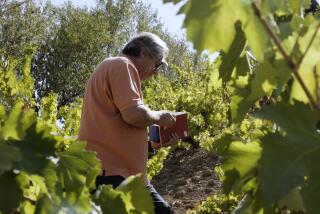Portugal coaxes a storied wine back from the brink
- Share via
CARCAVELOS, PORTUGAL — A 15-minute car ride west of downtown Lisbon, on a sliver of farmland cloistered by tightly bunched apartment blocks, the grape harvest is just in. And it looks like a storied Portuguese wine will be rescued from near-extinction.
The recent harvest of Carcavelos fortified wine coincided with the centenary of a 1908 law demarcating this wine region.
“From what we’ve tasted I think this will be a good year,” said head winemaker Estrela Carvalho.
Local authorities are spending $1.3 million to expand production and reinstate the reputation of what was once known internationally as “Lisbon wine,” one of Portugal’s old and almost forgotten treasures.
“We’re hoping to save part of our cultural heritage from extinction,” says Carlos Alberto Oliveira, a local official who is overseeing the relaunch. “It’s all about saving our legacy.”
The sweet white wine is usually taken as an aperitif or an after-dinner drink. The first record of it is a production contract from 1370. The business prospered from the 18th century, when its fame grew abroad.
The Duke of Wellington’s British troops sent here to help fight Napoleon’s invading armies in the early 1800s liked it so much they took it home. And characters in Dostoyevsky’s 19th century novel “Crime and Punishment” drank it.
But in the 1860s a deadly pest called phylloxera swept across Europe, killing vines from Portugal in the southwest to the Crimea in the east. Production in Carcavelos plunged from 396,000 gallons a year to 1,500 gallons.
In the 20th century, as suburban land prices soared, bulldozers cleared away the few wine-producing estates that were left.
The National Farming Center, a state research institution covering 320 acres in Carcavelos, came to the rescue in 1987, planting just over 12 acres of local vines to stop them from dying out. Carvalho was hired to oversee the project.
She quickly encountered a problem: Written records about how to make Carcavelos wine had perished along with the trade.
“It was like starting from scratch,” she says.
The local council is backing plans to add another 12 acres in February, eventually building to 50 acres by 2013.
The fields are corralled inside the Lisbon metropolitan area’s commuter belt. Apartment blocks up to six stories high hem in the vines from two sides, and a highway marks the northern boundary. The vineyard is an island of bucolic charm, flanked by shady lanes that are lined with cypress and olive trees.
The Atlantic Ocean is about a mile away. The humidity, chalky local soil, south-facing slopes and mild climate contribute to Carcavelos wine’s flavor. So do the Portuguese grape varieties that go into making it: boal, galego dourado and arinto.
The wine is matured for at least two years in barrels of Portuguese or French oak, then six months in the bottle. Depending on the blends and period of maturation, it ranges from a pale straw color for the younger wine to a deep shade of amber for the older.
Tasting a 1997 bottle, Carvalho swirls the wine around in a deep glass and sticks her nose inside. She rubs a finger and thumb together, looking for the right words. “It’s smooth, with traces of dried fruit . . . a suggestion of almonds and figs which it inherited from the oak,” she says.
Production last year reached 10,500 gallons. But it has dropped this year to just under 8,000 because of poor weather, which cut all Portugal wine production by about 30%.
The National Farming Center sells the wine for about $34 a bottle. Old bottles from private collections go for more than $137.
Joao Paulo Martins, author of several guides to Portuguese wines, noted that few people these days know what Carcavelos wine tastes like.
“It was a very, very interesting fortified wine, but it died,” Martins said. But he added: “There’s no reason why they can’t reach the past level of quality.”
More to Read
Sign up for Essential California
The most important California stories and recommendations in your inbox every morning.
You may occasionally receive promotional content from the Los Angeles Times.













